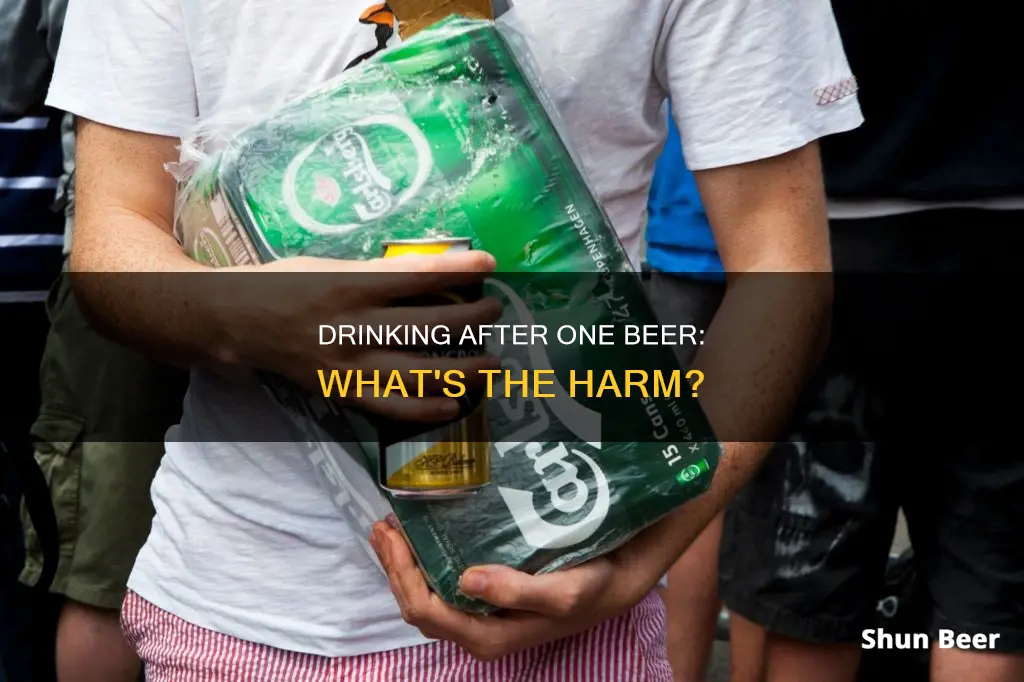
Drinking and driving is a dangerous combination. Even one beer can affect your ability to drive safely, increasing the risk of accidents and legal consequences. While the legal Blood Alcohol Concentration (BAC) limit in most places is 0.08%, the impact of alcohol on driving is significant even at lower levels. Alcohol slows down information processing, impairs judgement, reduces concentration, and affects your eyesight and coordination. These effects can lead to poor decision-making and slower reactions while driving, endangering yourself and others. Therefore, it is essential to understand how alcohol affects your body and make responsible choices when drinking and driving.
| Characteristics | Values |
|---|---|
| Alcohol metabolism rate | Varies between people and situations |
| Liver's processing capacity | 1 ounce of liquor per hour |
| Standard drink | 12-ounce beer |
| Time taken to metabolise a pint of beer | 2 hours |
| Factors affecting metabolism rate | Age, biological sex, body weight, food, other substances and medication, speed of drinking |
| Blood alcohol concentration (BAC) limit in the US | 0.08% |
| BAC limit in Europe | 0.05% |
| BAC limit in Scotland and Sweden | 0.02% |
| BAC increase from one standard drink | Up to 0.02-0.05% |
| Effects of alcohol on driving | Impaired judgment, reduced concentration, impaired eyesight, slowed reaction time, reduced coordination, impaired ability to track moving objects |
What You'll Learn
- Drinking one beer impairs judgement and ability to make informed decisions
- Alcohol concentration in the blood increases with more drinks
- One drink can affect your ability to see, causing double vision
- In the US, a BAC of .08 g/dL or higher is above the legal limit
- In Georgia, US, a young driver under 21 years of age can get arrested with a BAC between 0.02% to 0.05%

Drinking one beer impairs judgement and ability to make informed decisions
Drinking just one beer can impair your judgment and ability to make informed decisions. Alcohol affects the prefrontal cortex of the brain, which is responsible for decision-making and rational thinking. Even a small amount of alcohol can lead to impulsive and poor decision-making, as individuals are likely to act without considering the consequences of their actions.
When you drink alcohol, it slows down your body's processes. The information from your eyes takes longer to reach your brain, and your brain takes longer to process it. As a result, your reaction times are slower, and it becomes harder to make quick decisions. This can be particularly dangerous when driving or operating machinery.
Alcohol also affects your judgment and concentration. You may become more cautious, which can cause problems for other drivers if you don't react as expected. Your ability to carry out two tasks at once, such as steering and braking, is also impaired.
In addition, alcohol can alter your perception and processing of information, making it difficult to accurately assess situations. This can lead to poor decisions based on misinterpretation or misunderstanding. Your ability to evaluate risks is also impaired, and you may take risks while under the influence that you wouldn't normally take.
Drinking alcohol can also lead to emotional instability, amplifying emotions or causing mood swings, which can influence your decision-making. Additionally, it can decrease your cognitive control, leading to decisions that are inconsistent with your values or long-term objectives.
It's important to note that the effects of alcohol on decision-making can vary depending on factors such as the amount of alcohol consumed, the individual's tolerance, body weight, and other factors. Responsible drinking and understanding the effects of alcohol on the brain are crucial for minimizing the negative impact on judgment and decision-making abilities.
CO2 Cartridges: How They Keep Beer Fresh and Carbonated
You may want to see also

Alcohol concentration in the blood increases with more drinks
Alcohol concentration in the blood, or blood alcohol concentration (BAC), is a metric of intoxication that measures the amount of alcohol in the bloodstream. BAC is expressed as the weight of ethanol in grams in 100 milliliters of blood. As the number of drinks consumed increases, so does the BAC, leading to higher levels of intoxication and impairment.
The relationship between the number of drinks and BAC is influenced by various factors. Firstly, the alcohol by volume (ABV) or alcohol content in a drink determines how much alcohol is consumed with each drink. Beers, for example, can vary in ABV, and a higher ABV will result in a higher BAC. Secondly, individual factors such as body weight, gender, age, and genetics play a role in BAC levels. People with lower body weight tend to get drunk faster, and women generally have higher BAC levels than men after consuming the same amount of alcohol. Age also affects BAC, as the body's ability to metabolize alcohol decreases with age, resulting in higher BAC levels.
As BAC increases, the effects of alcohol become more pronounced. A BAC of 0.02% to 0.05% is typically associated with relaxation, euphoria, and impaired judgment. At 0.05% to 0.08%, which is the legal driving limit in many countries, there is a more significant impairment of judgment, reaction time, and motor skills. A BAC of 0.10% to 0.20% leads to impaired balance and memory, while levels above 0.35% can cause stupor, disordered breathing, coma, and even death.
It is important to note that drinking even one beer can affect an individual's coordination, judgment, concentration, and eyesight, all of which are crucial for activities such as driving. The effects of alcohol can vary depending on individual factors, and it is always important to drink responsibly and be aware of the potential risks associated with alcohol consumption.
Beer and Lipitor: Safe Mix or Health Risk?
You may want to see also

One drink can affect your ability to see, causing double vision
Even a single drink can affect your ability to see, causing double vision. This is because alcohol impairs the coordination of the muscles around the eyes. When you drink alcohol, the function of these muscles is impaired, which can result in double vision. This is a well-known short-term effect of alcohol consumption.
The impact of alcohol on eye muscles is one of several ways in which alcohol can affect vision. Alcohol can also cause blurred vision, slow pupil reactions, decreased peripheral vision, and decreased contrast sensitivity. These effects can occur even with moderate drinking and may last for several hours.
The impact of alcohol on vision is due to its effects on the brain and the eyes. Alcohol slows down communication between the eyes and the brain, impairing overall visual performance. It also affects the speed at which the iris constricts and dilates, reducing your ability to adapt to changes in lighting conditions.
In addition to the immediate effects on vision, heavy and long-term alcohol consumption can lead to permanent vision loss. Research has linked excessive drinking to an increased risk of macular degeneration and optic neuropathy, which can lead to blindness if left untreated. Therefore, it is important to be aware of the potential risks associated with alcohol consumption and to seek medical advice if you have any concerns about your vision or overall eye health.
Flooded Beer Font: How Does It Work?
You may want to see also

In the US, a BAC of .08 g/dL or higher is above the legal limit
Drinking and driving is a dangerous crime. Even if you've only had one beer, you should always ask yourself if you're in the right state to drive. If the answer is no, it's best to leave it to those who are sober. Understanding how alcohol is metabolised by your body is important in determining whether you're fit to drive.
In the US, a blood alcohol content (BAC) of 0.08 g/dL or higher is above the legal limit. This means that you are considered legally impaired. If your BAC is at or above this limit, you will be arrested for driving under the influence (DUI). Even if your BAC is below the legal limit, you can still be charged with a DUI if a police officer deems you noticeably impaired. This may be the case if, for example, you are under 21 or have children in the car.
The "One Hour Rule" states that you should only have one drink per hour and keep your BAC at around 0.08%. However, this rule is not always reliable, as different drinks have different alcohol concentrations, and people metabolise alcohol at different rates. Factors such as weight, age, and the amount of food in your system can also affect how your body processes alcohol.
It is important to remember that drinking, even in small amounts, can impair your coordination, judgement, and concentration. If you plan to drink, it is best to have a designated sober driver or arrange alternative transportation.
Drinking Beer on the Porch: Legal or Not?
You may want to see also

In Georgia, US, a young driver under 21 years of age can get arrested with a BAC between 0.02% to 0.05%
In the US, drinking and driving is a dangerous combination. Even small amounts of alcohol can impact your ability to drive safely. While the legal Blood Alcohol Concentration (BAC) limit for driving in the US is 0.08%, this only applies to drivers over 21 years of age. For younger drivers, the limit is much lower and varies by state between 0% and 0.02%.
> A person under the age of 21 shall not drive or be in actual physical control of any moving vehicle while the person's alcohol concentration is 0.02 grams or more at any time within three hours after such driving or being in physical control from alcohol consumed before such driving or being in actual physical control ended.
If a young driver in Georgia is found to have a BAC between 0.02% and 0.05%, they may face legal consequences, including fines, license suspension, community service, and participation in an alcohol risk reduction program. These laws are in place to prevent drunk driving, which is a significant problem in the US, particularly among underage drivers.
It's important to note that drinking even one beer can affect your judgment, coordination, and concentration, all of which are crucial for safe driving. The effects of alcohol on driving abilities can start at BAC levels below 0.02%, and the only way to effectively reduce your BAC is to avoid drinking altogether.
Neoprene Beer Coolers: How Do They Work?
You may want to see also
Frequently asked questions
No, it is not safe to drive after drinking any amount of alcohol. Alcohol affects your driving ability by impairing your judgment, slowing your reaction time, and inhibiting your coordination. Even if you are under the legal blood alcohol concentration (BAC) limit, you can still be a danger to yourself and others on the road.
It takes the liver roughly one hour to process one standard drink. However, this can vary depending on various factors, including age, body weight, metabolism, and whether the alcohol was consumed on an empty stomach. The only way to ensure that alcohol is completely out of your system is to wait it out.
Driving under the influence of alcohol is illegal and can result in serious legal consequences, including DUI charges, fines, and even jail time. More importantly, drunk driving puts yourself and others at risk of injury or death. In the United States alone, thousands of people die each year in alcohol-related accidents.







